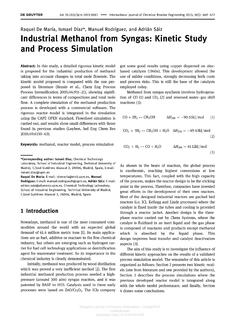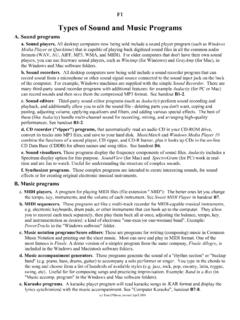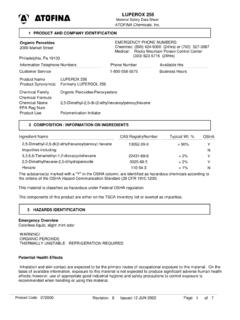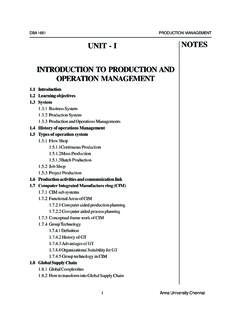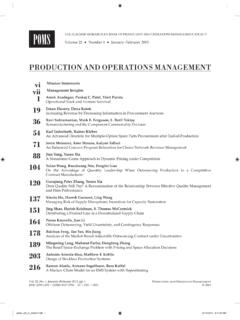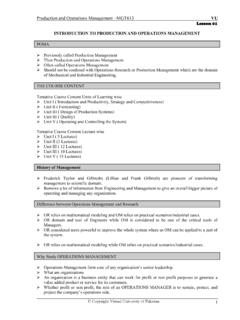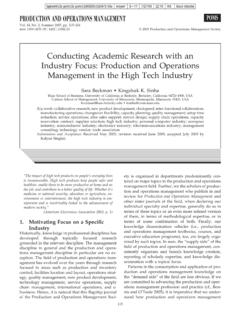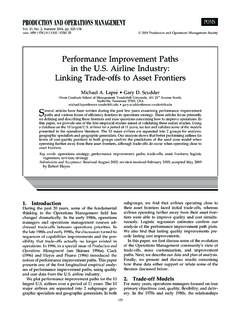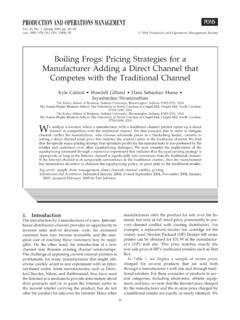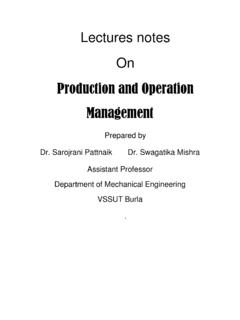Transcription of PRODUCTION AND OPERATIONS MANAGEMENT …
1 Performance Impacts of Strategy, InformationTechnology Applications, and BusinessProcess Outsourcing in PlantsIndranil Bardhan Sunil Mithas Shu LinSchool of MANAGEMENT , University of Texas at Dallas, Richardson, Texas 75083-0688, USAR obert H. Smith School of Business, University of Maryland, College Park, Maryland 20742, USAC raig School of Business, California State University, Fresno, California 93740-8001, paper develops a conceptual model to study the role of outsourcing strategies and plant-levelinformation technology (IT) application infrastructure in the outsourcing of PRODUCTION and supportbusiness processes, as well as their subsequent impact on overall plant performance. We validate thismodel empirically using cross-sectional survey data from manufacturing plants. We find that someIT applications are more effective at enabling the outsourcing of business processes than others.
2 Forexample, the implementation of enterprise MANAGEMENT systems is associated with the outsourcing ofboth PRODUCTION and support processes, whereas OPERATIONS MANAGEMENT systems are not associatedwith the outsourcing of plant processes. Plants with a low-cost outsourcing strategy are more likely tooutsource support processes than plants with a competency-focused outsourcing strategy. However,both cost- and competency-based strategies have a positive and similar impact on the outsourcing ofproduction processes. In terms of implications for plant performance, our findings indicate that theoutsourcing of PRODUCTION and support processes is associated with higher gross margins. Althoughplant IT infrastructure is positively associated with favorable on-time delivery rates, there is no positiveassociation between the incidence of plant outsourcing and on-time delivery rates.
3 These results haveimplications for crafting plant-level outsourcing strategies and for investments in IT systems to facilitatethe outsourcing of business processes for enhanced plant words: IT infrastructure; PRODUCTION process outsourcing; support process outsourcing; outsourcingstrategy; profitability; plant performance; business value of information technologySubmissions and Acceptance: Submissions and Acceptance: Received October 2005, revision receivedOctober 2006, accepted January 2007 by Sunder IntroductionIncreasing competitive intensity and globalization areforcing firms to shift from a strategy based on theownership of assets to leveraging the capability, scale,cost, cycle time, and innovation advantage of businesspartners (Apte and Mason 1995; Gottfredson, Puryear,and Phillips 2005; Niezen and Weller 2006). As com-panies buy raw materials and components from a vastnetwork of suppliers and locate their manufacturingplants in far-away countries, they increasingly rely ontheir vendors and business partners to coordinate themanufacturing and movement of goods across thevalue chain (The Economist2006).
4 Firms are realizingthe importance of developing their outsourcing capa-bilities and enter into arrangements with vendors tohandle both PRODUCTION processes ( , fabrication,assembly) and support processes ( , logistics, distri-bution, warehousing, information technology [IT],and product design). Similar to Cisco and Microsoft,many manufacturing plants outsource both produc-tion and support processes to achieve the efficienciesderived from the expertise of third-party companiesPOMSPRODUCTION AND OPERATIONS MANAGEMENTVol. 16, No. 6, November-December 2007, pp. 747 07 1606 747$ 2007 PRODUCTION and OPERATIONS MANAGEMENT Society747that specialize in these business processes (Bardhan,Whitaker, and Mithas 2006).Despite the growing importance of outsourcing andits critical role in supply chain MANAGEMENT , few stud-ies have empirically investigated the role of IT appli-cations in plant process outsourcing and their subse-quent impact on profitability and on-time previous research has investigated issuesrelated to IT applications and IT outsourcing (Aral,Brynjolfsson, and Wu 2006; Banker et al.)
5 2006;Choudhury, Hartzel, and Konsynski 1998; Cotteleer2006; Cotteleer and Bendoly 2006; Dibbernet ;Hitt, Wu, and Zhou 2002; McAfee 2002; Mithas andJones 2007; Whitaker, Mithas, and Krishnan 2007),none of these studies have investigated the role of ITapplications and outsourcing strategies as they relateto the outsourcing of plant processes and plant study poses the following research questions:(a) What is the impact of IT application infrastructureon the extent of outsourcing of PRODUCTION and sup-port processes? (b) What is the role of outsourcingstrategies in determining the extent of PRODUCTION andsupport outsourcing? (c) What is the subsequent im-pact of PRODUCTION and support outsourcing on prof-itability and on-time delivery? We develop our theo-retical framework by drawing on prior research inoperations MANAGEMENT and information systems (IS)to link IT application infrastructure, process outsourc-ing, and plant performance.
6 We then empirically val-idate our model by analyzing data for a cross-sectionof manufacturing plants, accounting for the roleof contextual variables, such as plant characteristicsand industry work extends previous research in the supplychain MANAGEMENT and the IS literature in two impor-tant ways (Kouvelis et al. 2006). First, ours is the firststudy to examine the impact of two major types ofplant IT applications enterprise MANAGEMENT sys-tems (EMS) and OPERATIONS MANAGEMENT systems(OMS) on PRODUCTION and support outsourcing. Byfocusing on specific IT applications and examiningtheir impact on both PRODUCTION and support out-sourcing, we gain a more complete understanding ofhow IT systems affect plant performance. In doing so,we extend previous research that has studied the ef-fect of aggregate IT expenditures only on productionoutsourcing (Bardhan, Whitaker, and Mithas 2006).
7 This contribution complements prior research that hasargued for the critical role of IT infrastructure as anenabler of organizational capabilities and organiza-tional performance (Barua and Mukhopadhyay 2000;Brynjolfsson and Hitt 1996; Buhman, Kekre, and Sin-ghal 2005; Kauffman and Kriebel 1988; Lucas 1993;Mithas et al. 2005b; Rai, Patnayakuni, and Seth 2006;Sambamurthy, Bharadwaj, and Grover 2003) and fo-cuses attention on the role of PRODUCTION and supportoutsourcing as important mediators of the relation-ship between IT infrastructure and plant , this study shows how strategic consider-ations affect plant outsourcing and have performanceimplications. In contrast with previous work that hasstudied the impact of generic plant-level strategies onproduction outsourcing and performance (Bardhan,Whitaker, and Mithas 2006), we relate a more specificdimension of plant strategy ( , outsourcing strategy)with the outsourcing of PRODUCTION and support pro-cesses and the subsequent impact on profitability andon-time delivery (Thurm 2007).
8 This contribution re-sponds to a recent call to broaden the OPERATIONS strat-egy literature by understanding the role of strategiesthat go beyond manufacturing strategy (Boyer, Swink,and Rosenzweig 2005; Ketokivi 2006) and to under-stand the mechanisms that mediate the links betweenstrategies and profitability (Rosenzweig and Roth2004).We organize the remaining sections as follows. InSection 2, we review the background literature anddevelop our research hypotheses. In Sections 3 and 4,we discuss the estimation methodology and presentthe results, respectively. Section 5 provides a discus-sion of the results and offers some concluding Background and TheorySeveral macroeconomic factors, including globaliza-tion, competitive pressures, and the need to leverageavailability of the talent pool across national bound-aries led to the emergence of outsourcing as an impor-tant vehicle for plants to contract their business pro-cesses to external providers to reduce costs and obtainaccess to specialized resources.
9 The outsourcing ofbusiness processes in manufacturing plants involvesnot only procurement of products and services fromexternal vendors but also transfer of the responsibilityfor the business processes and related knowledge tothird parties. The information associated with theseprocesses may involve a combination of tacit and ex-plicit knowledge. The effective MANAGEMENT of infor-mation processes across inter- and intra-organiza-tional boundaries is extremely challenging as a resultof several factors: volatility in customer requirementsand external market conditions, lack of suitable ITinfrastructure, information security, and the lack ofcommon standards or processes to facilitate seamlessknowledge prior literature suggests three primary reasonsfor the outsourcing of business processes: (a) lowercosts associated with the scale economies and greaterBardhan, Mithas, and Lin:Performance Impacts in Manufacturing Plants748 PRODUCTION and OPERATIONS MANAGEMENT 16(6), pp.
10 747 762, 2007 PRODUCTION and OPERATIONS MANAGEMENT Societyefficiencies provided by outsourcing vendors, (b) thetransfer of risks associated with market and techno-logical uncertainty to an external organization, and (c)access to specialized skills and resources that the clientdoes not possess (Kakabadse and Kakabadse 2002).Outsourcing also provides firms with greater flexibil-ity in the deployment of resources in the face of rap-idly changing technologies and increasing complexityof product development (Gosain, Malhotra, and ElSawy 2005; Ketokivi 2006). Researchers argue that anetwork of suppliers could provide the capabilitiesnecessary for a manufacturing plant to adjust the scaleand scope of its PRODUCTION facilities at a lower cost inresponse to volatile market conditions (Quinn 1994). Iffirms can leverage a network of high-quality suppliersto collaborate with across the value chain, outsourcingmay also be associated with a decrease in lead times(Quinn and Hilmer 1994).
